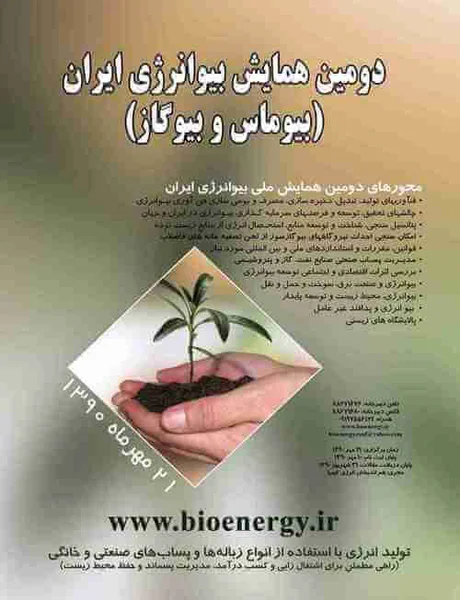-
evaluation biomass for power distributed generation in iran
جزئیات بیشتر مقاله- تاریخ ارائه: 1390/07/09
- تاریخ انتشار در تی پی بین: 1390/07/09
- تعداد بازدید: 414
- تعداد پرسش و پاسخ ها: 0
- شماره تماس دبیرخانه رویداد: -
the iran has a significant biomass resource, estimated at an annual 20 million tonnes, but only a fraction of this is captured effectively for energy, contributing approximately 4.1% of the iran’s heat and electricity production. much biomass combustion technology may be considered as mature, although bottlenecks in the quality and quantity of feedstock are apparent, and further fundamental research is required to increase crop yield in a sustainable manner, with low chemical inputs to ensure efficient energy balance. in the short term, it could be useful for the iran to focus on developing a limited number of bioenergy chains, linked to combined heat and power microgeneration and the use of bioenergy for community and public sector projects. this should be linked to a joined up policy and regulatory framework. a clear strategy for land management is also required, since many competing uses for land will emerge in the coming decades, including food production, nature conservation, carbon sequestration, urbanisation and other forms of renewable energy use. this finite resource must be managed effectively. in the long term future, considerable excitement exists about the possibility of new bioscience technologies harnessed to improve photosynthetic gains for bioenergy, including the use of synthetic biology. it may be possible to produce the designer energy plant whose outputs would include high quality chemical and liquid biofuels. gasification of biomass also requires further technology development.
مقالات جدیدترین رویدادها
-
استفاده از تحلیل اهمیت-عملکرد در ارائه الگوی مدیریت خلاقیت سازمانی و ارائه راهکار جهت بهبود
-
بررسی تاثیر ارزش وجوه نقد مازاد بر ساختار سرمایه شرکت های پذیرفته شده در بورس اوراق بهادار تهران
-
بررسی تأثیر سطح افشای ریسک بر قرارداد بدهی شرکت های پذیرفته شده در بورس اوراق بهادار تهران
-
بررسی تأثیر رتبه بندی اعتباری مبتنی بر مدل امتیاز بازار نوظهور بر نقد شوندگی سهام با تأکید بر خصوصی سازی شرکت ها
-
تأثیر آمیخته بازاریابی پوشاک ایرانی بر تصویر ذهنی مشتری پوشاک ایرانی (هاکوپیان)
-
تاثیر مدارس طبیعت در نهادینگی فرهنگ زیست گرایی جامع بشری
-
مقایسه عوامل مؤثر بر عدم گرایش به نگارش مقالات علمی از دیدگاه اعضای هیأت علمی علوم پایه و بالینی دانشگاه علوم پزشکی همدان
-
بررسی قابلیت لحیم کاری سخت هاردمتال تنگستن کاربید کبالت به فولاد ابزار
-
towards a steady forming condition for radial–axial ring rolling
-
contraction behaviors of dental composite restorations — finite element investigation with dic validation
مقالات جدیدترین ژورنال ها
-
مدیریت و بررسی افسردگی دانش آموزان دختر مقطع متوسطه دوم در دروان کرونا در شهرستان دزفول
-
مدیریت و بررسی خرد سیاسی در اندیشه ی فردوسی در ادب ایران
-
واکاوی و مدیریت توصیفی قلمدان(جاکلیدی)ضریح در موزه آستان قدس رضوی
-
بررسی تاثیر خلاقیت، دانش و انگیزه کارکنان بر پیشنهادات نوآورانه کارکنان ( مورد مطالعه: هتل های 3 و 4 ستاره استان کرمان)
-
بررسی تاثیر کیفیت سیستم های اطلاعاتی بر تصمیم گیری موفق در شرکتهای تولیدی استان اصفهان (مورد مطالعه: مدیران شرکتهای تولیدی استان اصفهان)
-
رابطه اشتیاق شغلی و رشد حرفه ای معلمان بر بالندگی سازمانی در معلمان مقطع اول متوسطه شهرستان خنجین
-
تاثیر تمرکز بازار حسابرسی، تخصص حسابرس در صنعت و تجربه کمیته حسابرسی بر قیمت گذاری حسابرسی
-
مدل سازی خرید مد آنلاین: ارزیابی مبتنی بر خرید حر فه ای مد آنلاین
-
راهکارهایی جهت پرورش ادراک موسیقایی دانش آموزان پایه ابتدایی (مطالعه موردی: بازی و سرگرمی)
-
بررسی نقـش شاخص های بازاریابی در توسعه صنعت گردشگری ورزشی




سوال خود را در مورد این مقاله مطرح نمایید :